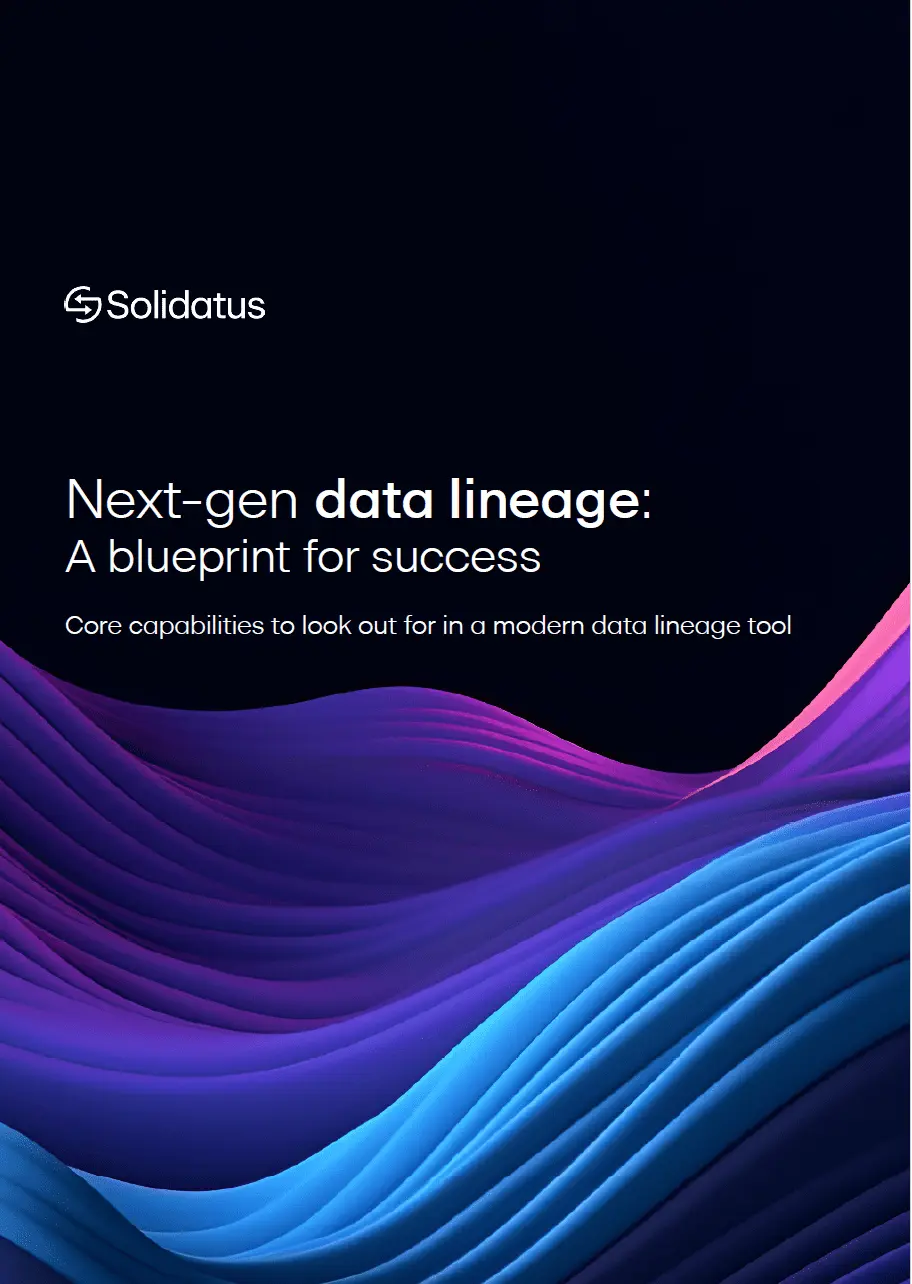What Is data lineage and how can it benefit you?

Try Solidatus' leading data lineage
What is data lineage
First, ask yourself what does lineage mean?
To understand something’s lineage is to know where it came from and to know the path it took over its lifecycle to get here, including all the various encounters and events that transformed it along the way. And so it is with data lineage.
At its core, data lineage provides a clear and visual representation of data provenance, essential for any organization. It offers a continuously updated record, with which the user can then.
- Determine the data’s point of origin
- Track the movement of data through an organization
- Observe it’s various transformations along the way
- Keep a log where the data has been stored along the way
- Keep a log of where the data has been accessed along the way
- Keep records of other vital metadata.
Most importantly this visualization is not just about tracking your data but also understanding the intricate processes and dependencies involved in data flow, whether cloud-based or within a physical premises.
However, data lineage is more than just a documentation of data flows and paper trails. It’s a comprehensive map of all the direct and indirect relationships between data entities within an organization. This detailed mapping is the cornerstone of a modern data stack, providing complete visibility and helping to identify and address data blind spots. It plays a pivotal role in ensuring ethical, compliant, and efficient data management.
By understanding these dependencies and interactions within your data systems, data lineage allows for more informed decision-making. It helps you to assess the impact of changes in data algorithms on various reports and forecasts. It can assist you in understanding the usage and purpose of regulated data and provide valuable guidance when selecting optimal test cases for new database applications, and strategizing cloud migration without jeopardizing the existing systems that you’ve worked to maintain.
Simply put, data lineage empowers organizations to fully utilize their data and unlock its potential. Utilizing it successfully can lead to:
- Enhanced infrastructure optimisation
- Better operational efficiency
- Minimized risk
There are all things that align perfectly with Solidatus’ commitment to intelligent data management and discovery.
Why is Data Lineage Important?
Reliable, automated data lineage is crucial in ensuring the accuracy and trustworthiness of an organization’s data, a cornerstone in modern data management. It provides transparency into the data’s journey from its origin to its final destination, highlighting every transformation and process it undergoes. This clarity is essential for business analysts and IT professionals alike, as it offers visibility into the data’s correctness and streamlines the management process by automating lineage extraction, moving away from manual, time-consuming methods.
The importance of data lineage extends to four key areas that impact the entire business:
Regulatory compliance:
Data lineage is indispensable for adhering to regulatory standards, offering a detailed record of data origins, modifications, and usage. This aspect is crucial for responding to audits and ensuring that data handling meets legal requirements.
Operational efficiency:
By automating data mapping and reducing the need for manual impact analysis, data lineage tools significantly save time and resources. They enable a more proactive approach to managing data changes, thereby enhancing overall operational efficiency.
Data security and privacy:
In the realm of data privacy and security, data lineage provides an essential framework. It helps organizations track the flow of sensitive data, ensuring alignment with policies and controls, and identifying potential risks in data flows.
Data analytics and customer experience:
For data analytics and customer experience initiatives, understanding the flow and transformation of data is key. Data lineage supports these efforts by providing a clear map of data dependencies and interactions, aiding in gap identification and resolution.
Furthermore, data lineage is instrumental in successful cloud data migrations and modernization projects. It allows for a deeper understanding of data relationships and dependencies, facilitating effective change management and minimizing risks associated with data transformation
In summary, data lineage is not just about tracking data; it’s about empowering organizations to make informed decisions, ensuring compliance, enhancing security, and driving efficiency. These benefits align seamlessly with Solidatus’s dedication to providing intelligent solutions for data management and discovery.
What specific issues can data lineage address?
Data lineage, a vital aspect of contemporary data management, offers insightful solutions to numerous queries within an organization. It’s not just about tracing data’s path; it’s about understanding its journey and impact.
Here are some key questions that data lineage helps to answer:
Regulatory compliance and governance
Data lineage illuminates which segments of your enterprise’s data require governance to comply with both local and industry-specific regulations. This insight is crucial for maintaining legal and ethical standards in data handling.
Customer experience development
It identifies the data sources containing personal information crucial for crafting new customer experience strategies. Understanding how this sensitive data is spread across your organization is key to developing targeted and effective initiatives.
Cloud migration decisions
Data lineage aids in determining the suitability of data for cloud migration. It provides insights into how such a move would impact user experience and ensures that data migration aligns with organizational data governance policies.
Data quality management
It helps in tracking how data quality evolves through various stages of processing. This is essential for maintaining high standards of data integrity and reliability across the organization.
Advanced analytics support
For data scientists, data lineage boosts confidence and trust in the data used for advanced analytics. It ensures that the data is accurate, up-to-date, and relevant, thereby enhancing the quality of analytical insights.
By addressing these questions, data lineage not only aids in strategic decision-making but also aligns perfectly with Solidatus’s commitment to intelligent data management and discovery. It empowers organizations to utilize their data assets effectively, ensuring compliance, enhancing operational efficiency, and minimizing risks.
What are the main types of Data Lineage?
Data lineage, a key component in modern data management, can be categorized into three main types: business lineage, technical lineage and End-to-End Lineage. Each type serves a unique purpose and caters to different aspects of data management, aligning with the comprehensive solutions offered by Solidatus.
Business lineage
This form of lineage is designed for simplicity and accessibility, primarily catering to business analysts. It provides a high-level overview, illustrating the journey of data from its source to the final report. This summary view is crucial for analysts who need to verify the reliability of their data sources without getting entangled in the intricate details of every data alteration. Business lineage is about offering a clear, interactive map that traces data flows, ensuring that the data used is dependable and sourced correctly.
Technical lineage
In contrast, technical lineage delves into the finer details, tailored for IT professionals and data architects. It offers an in-depth view of data transformations and allows users to drill down to specific details like table, column, and query-level lineage. This detailed perspective is essential for navigating complex data pipelines and understanding the nuances of data transformations. Technical lineage provides a comprehensive view, enabling IT experts to manage and architect data with precision.
When combined, business and technical lineage offer an integrated view of an organization’s data landscape. This dual approach ensures that data citizens across various departments and roles have the necessary tools and insights to make accurate and informed business decisions. By integrating both business and technical perspectives, data lineage tools facilitate a more nuanced and effective approach to data management, aligning with Solidatus’s vision of empowering organizations through intelligent data solutions.
Data lineage best practices
Implementing and planning data lineage requires a strategic approach to ensure effective data management, aligning with the intelligent solutions provided by Solidatus.
Here are some best practices to consider:
Embrace automation for data lineage extraction
In today’s fast-paced and ever-changing data environment, relying on manual methods like Excel for capturing data lineage is outdated. Automation is key to keeping up with the dynamic nature of data, ensuring that lineage is captured accurately and efficiently.
Incorporate metadata sources in data lineage
Data lineage should include metadata from various sources such as ETL software, BI tools, relational database management systems, modelling tools, and custom applications. This metadata is crucial for a comprehensive understanding of your data’s journey from its origin to its destination.
Engage metadata source owners
Collaboration with the owners of metadata sources is essential. These individuals have the best understanding of the metadata’s timeliness, accuracy, and relevance. Their involvement is crucial in verifying and ensuring the integrity of data lineage.
Plan for progressive metadata and data lineage extraction
Mapping out the data’s path through your systems is the first step. Following this, progressively extract metadata and data lineage from each system. This methodical approach simplifies the mapping of connections, relationships, and dependencies within and among systems.
Validate lineage in stages
Begin with validating high-level connections between systems, then progressively drill down into datasets and data elements. The final step should be the validation of transformation-level documentation. This staged approach ensures thoroughness and accuracy in lineage validation.
Utilize an enterprise-class data catalog
For comprehensive, end-to-end lineage that spans both cloud and on-premises environments, an enterprise-class data catalog is indispensable. Choose a catalog that can automatically integrate lineage from all enterprise sources. This should include capabilities for extracting and inferring lineage from metadata, ensuring a granular and complete lineage view.
The benefits of data lineage for your business
Enhanced regulatory compliance and risk management
Truly Automated Data lineage is instrumental in navigating the complex landscape of regulatory compliance. By providing a detailed map of data flows, it enables organizations to adhere to standards like BCBS239, CCPA, GDPR, and more. This comprehensive visibility not only aids in audit trails and risk assessment but also significantly reduces the risk of non-compliance penalties.In-depth understanding and trust in data
Data lineage demystifies the data journey, offering clarity on its origin, transformations, and quality. This transparency is crucial for business users, ensuring that the data driving business decisions is accurate, complete, and reliable. It fosters a culture of trust in data, which is fundamental for insightful decision-making.Streamlined impact analysis
Our data lineage technology revolutionizes impact analysis, allowing IT teams to efficiently trace changes in data across systems. This automation saves significant time and resources, previously consumed by manual analysis, enhancing productivity and allowing IT professionals to focus on strategic initiatives.Accelerated incident prevention and resolution
Data lineage contributes significantly to IT resilience. It aids in predicting and preventing incidents, whether they stem from cyber threats, natural disasters, or infrastructure failures. By providing a clear view of data dependencies and transformations, lineage tools enable quicker identification and resolution of data-related issues.Optimized data migration and cloud integration
As businesses increasingly move towards cloud-based solutions, data lineage simplifies the migration process. It ensures a thorough understanding of data dependencies, facilitating smoother transitions with minimal disruption. This efficiency is critical in leveraging cloud technologies effectively and economically.Empowerment of data engineering and analytics teams
Effective data lineage strategies alleviate the burden of routine tasks from data engineers and scientists. By automating data tracking and providing self-service access to data origins and lineage, these tools enable faster onboarding and integration of new team members, enhancing the overall productivity and stability of data operations.Building trust and confidence in data governance
In today’s complex data environments, having a comprehensive overview of data sources and flows is essential. Automated Data lineage offers this overview, ensuring accurate reporting and solidifying confidence in the organization’s data management strategy. This trust is crucial for stakeholders who rely on data for critical business decisions.Facilitating effective change management
Automated Data lineage plays a vital role in change management processes. It provides the visibility needed to understand the impacts of proposed changes, aiding in securing executive support and ensuring alignment across the organization. This visibility is key to managing multiple changes simultaneously, reducing the complexity associated with interconnected data systems.Data lineage use cases
Streamlining regulatory compliance
Empowering self-service analytics
Facilitating impact analysis
Enhancing data exploration and viability
Assisting in rationalization and cloud migration
Optimizing asset management






